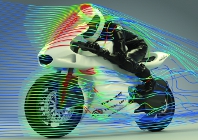Back in 2009 small Californian composites firm Taylormade Racing decided to blow all its previous year’s profits by taking on international motorbike racing.

Using the scanned data, TotalSim could carry out aerodynamic analysis on the model
It would build a Grand Prix bike to showcase its carbon fibre expertise, one that would rewrite all the engineering rules.
British-based designer John Keogh, in partnership with team manager Paul Taylor, was the instigator of this radical redesign, targeting the bike at the new Moto2 class.
With a stock Honda CBR600 engine, but completely free chassis design, Keogh immediately set to work drawing up the general layout and ignoring pretty much all the normal conventions of motorcycle design:
All production motorcycles have their radiators in front of the engine. Theirs would be under the seat. Most motorcycles use telescopic forks as front suspension. This would have a wishbone system.
All current racing motorcycles have a full aerodynamic fairing. This would have only shielding for the rider’s head and shoulders.
No motorcycle since the Ariel Arrow of 1959 has had a full monocoque chassis and none have used carbon fibre as its material, as Taylormade would.
In addition it would have the swing-arm – the heaviest component – made of the same composite.
A tall central fuel tank would be added to minimise weight shift with diminishing fuel load. This clashed with the need to duct air from the high-pressure on the nose back through the headstock, over the mandated airbox and to the underseat mounted radiator.
The solution: a ‘doughnut’ duct that would go straight through the middle of the fuel cell.
Model work
As the first drawings were done Taylor began building a ‘buck’ – a physical model – around the Honda engine in wood and foam that would form the basis of the monocoque chassis and fuel tank.
An initial CAD model was also built, but as the designs progressed, the CAD model wasn’t reflecting the bike build on the ground. Rather than spend time correcting this Keogh felt it better to 3D scan the physical reality of the bike.
Mouldings already existed for the chassis, nose and tail so the option to scan the bike was seen as an ideal way to accelerate the program, to provide the necessary exact digital model and offer an opportunity to use CFD for aerodynamic testing and verification.
3D Scan Alliance, a UK consultancy, suggested the best 3D scanning equipment and process for the team’s requirements. It recommended a ‘structured light’ 3D scanner, as opposed to a laser-based device.
Structured light scanners are often more associated with metrology type applications due to their potentially ultra-high accuracy and resolution.
The suggested Solutionix Rexcan CS was selected for its fast ‘Blue LED’ technology.
Capable of scanning the dark surface of the body panels in 1.5 hours in total, the subsequent mesh processing took about 30 minutes.
The full digital representation of the bodywork, that was taking shape in the US, could now be shared between design work in the UK and other contributing parties.
Dublin, Ohio-based CFD specialists TotalSim USA, had done some initial work on the CAD model but could now use the more accurate scan-data based model.
Problem solved
When it came to the first shakedown of the actual bike a significant overheating problem surfaced.
Using the scanned data with the addition of a scanned but fixedposition rider, the digital version was put through its paces. Immediately it was obvious that the front duct was compromised on its inner upper surface, losing the flow and thereby starving the rear radiator of cooling air.
A belt-and-braces operation of enlarging the duct, increasing the radiator core size and altering its angle solved the cooling problem.
The end result is a highly potent race bike with a unique design heavily reliant on reverse engineering through scanning and hands-on modelling. 
Solutionix Rexcan speeds up the design of Taylormade Racing’s Grand Prix bike
Default







